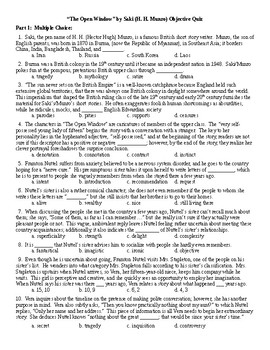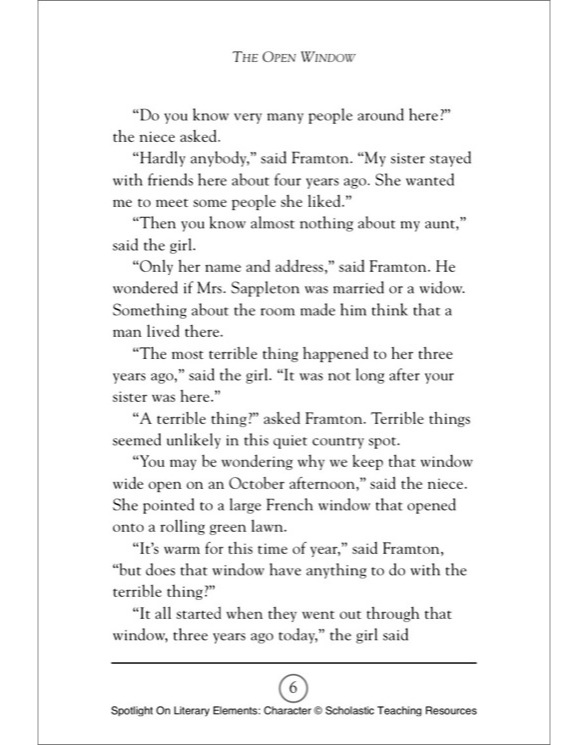
Oct 08, · Advanced | Exemplar Essay Open Window. Using Exemplars in Your Lessons. Exemplar essays are tools to take abstract descriptions and make them more concrete for students. One way to use them is to print the clean copies of the essays and allow students to use the rubric to make notes or even find examples of important elements of an essay - thesis The Open Window study guide contains a biography of Saki (Hector Hugh Munro), literature essays, quiz questions, major themes, characters, and a full summary and analysis. Best summary PDF, themes, and quotes In "The Open Window," by Saki, Vera's awareness of the lack of knowledge from Mr. Nuttel about her family was an important factor to accomplish her purpose of relating to Mr. Nuttel the terrifying story of how her three uncles never came back from snipe-shooting and how her poor aunt always thinks that her husband and her two brothers will come back.3/5(2)
The Open Window The Open Window Summary and Analysis | GradeSaver
Saki is the pen name of the British writer Hector Hugh Munro, also known as H. Munro In " The Open Window ," possibly his most famous story, social conventions and proper etiquette provide cover for a mischievous teenager to wreak havoc on the nerves of an unsuspecting guest. Framton Nuttel, seeking a "nerve cure" prescribed by his doctor, the open window essay, visits the open window essay rural area where he knows no one. His sister provides letters of introduction so he can meet people there. He pays a visit to Mrs. While he waits for her, her year-old niece keeps him company in the parlor.
When she realizes Nuttel has never met her aunt and knows nothing about her, she explains that it has been three years since Mrs. Sappleton's "great tragedy," when her husband and brothers went hunting and never returned, presumably engulfed by a bog which is similar to sinking in quicksand. Sappleton keeps the large French window open every day, hoping for their return. When Mrs. Sappleton appears she is inattentive to Nuttel, talking instead about her husband's hunting trip and how she expects him home any minute. Her delusional manner and constant glances at the window make Nuttel uneasy. Then the hunters appear in the distance, and Nuttel, horrified, grabs his walking stick and exits abruptly.
When the Sappletons exclaim over his sudden, rude departure, the niece calmly explains that he was probably frightened the open window essay the hunters' dog. She claims that Nuttel told her he was once chased into a cemetery in India and held at bay by a pack of aggressive dogs. The niece uses social decorum very much to her favor. First, she presents herself as inconsequential, telling Nuttel that her aunt will be down soon, but "[i]n the meantime, you must put up with me. And it provides perfect cover for her mischief. Her next questions to Nuttel sound like boring small talk. She asks whether he knows anyone in the area and whether he knows anything about her aunt.
But as the reader eventually understands, these questions are reconnaissance to see whether Nuttel will make a suitable target for a fabricated story. The niece's prank is impressively underhanded and hurtful. She takes the ordinary events of the day and deftly transforms them into a ghost story. She includes all the details needed to create a sense of realism: the open window, the brown spaniel, the open window essay, the white coat, and even the mud of the supposed bog. Seen through the ghostly lens of tragedy, all of the ordinary details, including the aunt's comments and behavior, take on an eerie tone. The reader understands that the niece won't get caught in her lies because she's clearly mastered a lying lifestyle. She immediately puts the Sappletons' confusion to rest with her explanation about Nuttel's fear of dogs.
Her calm manner and detached tone "enough to make anyone lose his nerve" add an air of plausibility to her outrageous tale. One of the most engaging aspects of this story is that the reader is initially duped, too, just like Nuttel. The reader has no reason to disbelieve the niece's "cover story"—that she's just a demure, polite girl making conversation. Like Nuttel, the reader is surprised and chilled when the hunting party shows up. The open window essay unlike Nuttel, the reader finally learns the truth of the situation and enjoys Mrs. Sappleton's amusingly ironic observation: "One would think he had seen a ghost.
Finally, the reader experiences the niece's calm, detached explanation, the open window essay. By the time she says, "He told me he had a horror of dogs," the reader understands that the real sensation here is not a ghost story, but rather a girl who effortlessly spins sinister stories. Share Flipboard Email. By Catherine Sustana The open window essay Sustana. Catherine Sustana, Ph. Learn about our Editorial Process. Featured Video. Cite this Article Format. Sustana, Catherine. Analysis of "The Open Window" by Saki. copy citation. A Closer Look at "A Ghost Story" by Mark Twain, the open window essay. Analysis of 'Gryphon' by Charles Baxter. Analysis of 'Snow' by Charles Baxter.
Analysis of The Bear Came Over the Mountain by Alice Munro. Analysis of "Oliver's Evolution" by John Updike. Supernatural and Spooky Events of the s. What Is a Foil Character in Literature? Biography of Anne Brontë, English Novelist.
Short Story - The Open Window by saki
, time: 11:59FREE The Open Window Essay

The Open Window study guide contains a biography of Saki (Hector Hugh Munro), literature essays, quiz questions, major themes, characters, and a full summary and analysis. Best summary PDF, themes, and quotes The short story "The Open Window" by Saki gives us a marvelous example of how appearance, semblance and our naivety can distract our attention from reality and even make harm to our health. This story also shows how a writer can make perfect use of “I’ll open the Window” explains the changes and benefits to the end of a long, tiresome relationship through personification, imagery, and onomatopoeia. On the contrary, “Flirtation” by Rita Dove conveys a change from loneliness to the positive parts of having a relationship through similes, metaphors, personification, and short stanzas
No comments:
Post a Comment